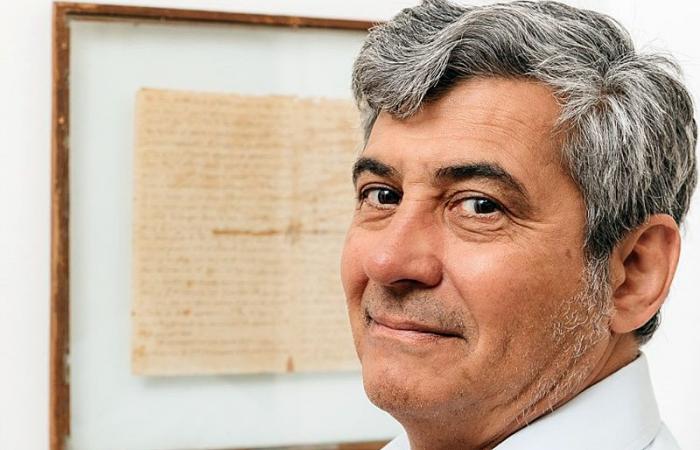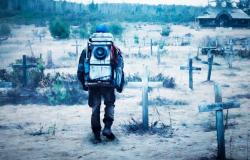That evening of June 27, 1881 was especially cold in Buenos Aires. Florentino Muñiz, a multifaceted Spaniard, was part of the organization The Dark Knights, led by the Belgian Alphonse Kerckhove de Peñaranda. Muñiz had decided to have coffee in a bar and, while reading the evening newspaper, his eyes came across the chronicle and a hitherto unthinkable idea: kidnapping the body of the richest woman in the country at that time, Doña Inés Indart Igarzábal de Dorrego , from the Recoleta Cemetery.
Thus began an unprecedented plot in the history and origins of crime in Argentina, in the hands of the country’s first gang of kidnappers. About this police case that kept Argentine society at the end of the 19th century in suspense and scandalized, he writes Daniel Balmaceda in his latest book, The Dark Knights.
The journalist, a member of the Argentine Academy of History and one of the country’s greatest popularizers, tells the incredible – and fascinating – story of a group of European immigrants who make up a criminal gang, which acted at night, camouflaged itself during the day ( and with its own regulations), who even stole a corpse from the Dorrego family for ransom.
After bestsellers such as Great Stories of Argentine Cooking, Stories of the Argentine Belle Époque and Sarmiento, Balmaceda is encouraged to try the historical narrative genre for the first time and it once again becomes one of the books that has led the sales rankings since its inception. publication. The history that Balmaceda touches turns into gold. “The Dark Knights is a historical police narrative, but it is an intermediate step towards the novel,” says Balmaceda in dialogue with Noticias Argentinas, and explains the reasons: “It is a real event, which took place in 1881, and where each member of the band that appears in the book participated in these events. The novel is a very attractive genre and, at the same time, far from non-fiction, where we can give ourselves the pleasure of generating environments, settings, characters and situations.”
The book, which is published for the first time simultaneously in Argentina, Latin America and Spain, is the product of more than five years of research, based on all kinds of material: “It is a fascinating police case and that is why it seemed to me that it was an excellent opportunity to enrich the environment with illustrative data of the time and provoke in the reader a complete scenography of these events,” adds the author.
The Dark Knights recreates a crucial period in Argentine History, at the end of the 19th century in Buenos Aires, marked by important political, social and economic transformations. Roca’s presidency, the creation of the Federal Police, led by Marcos Paz, and the descriptions and details of the palaces where the city’s wealthy families resided, are elements that place the reader in the atmosphere of the time. The book has the author’s seal: chapters that lead to a chained and hypnotic reading.
“The police officer makes a very complete outline of a society,” defines Balmaceda, in line with an idea that the writer and journalist from Rosario, Reynaldo Sietecase, was able to express when he said that “a society is shown in a police officer like in no other genre.” . And he adds: “Police crime is a genre that involves action, in many cases, actions on the street, different personalities, different social classes, wrong behaviors.”
How did they manage to remove the coffin of the richest woman in the country from the Recoleta Cemetery? Where did they hide it? What were they asking for as a ransom? These are some questions that guide the narrative of The Dark Knights. And, a fundamental question: What were the strategies to evade the newly created Capital Police? A more daring plan and with the perfect victim.
A “trustworthy” band
Three Italians, two French, one Greek and one Algerian, led by a Belgian, Alphonse Kerckhove de Peñaranda, and a Spaniard, Florentino Muñiz. This is how the unusual band of kidnappers was formed, “The Knights of the Night”, which stars in the Argentine journalist’s new book.
The name is not coincidental, for several reasons. The name, as Balmaceda explains to NA, was inspired by the French detective novel Les chevaliers de la nuit, by Pierre-Alexis Ponson du Terrail – known for the creation of the famous character Rocambole. “The Knights of the Night was a gang that was formed in Buenos Aires at the beginning of 1881 with the intention of committing crimes and transcending their actions, to the point of becoming the most renowned gang in the region,” says Balmaceda.
At the same time, it refers to the novel of the same name and one more aspect of the band’s mysterious name: “Their name was taken from a French novel, but it implied something else: that during the day they all had regular jobs, as a waiter, a pharmacy supplier. , administrative, but at night they became the gang of criminals. “His big coup was the kidnapping of the body of the richest woman at that time.”
The book shows this double face: by day citizens like any other, hard-working and honest; At night, everything became clandestine. “The Dark Knights” practiced anonymity and naming by numbers, similar to what happens in the series Money Heist or the movie Perros de la calle.
This group had another peculiarity: it was made up of immigrants exclusively, Argentines were not accepted. Because? According to the book, Kerckhove de Peñaranda and Muñiz, the leaders, did not trust the Argentines because they were not trustworthy. They even generated a code of conduct for their members, which consisted of 13 maxims, among which was one of the most surprising: “Always be silent with whom you have to keep silent and what you have to keep silent about. Mystery, secret and silence, in everything, for everything and with everyone.”
Balmaceda’s book narrates this fascinating police case in four parts, however, the big question is how this gang managed to achieve the first kidnapping of a corpse. Intelligence, details, strategy and knowing how to take advantage of opportunities.
A kidnapping that was not the last
When reading The Dark Knights and the details of the kidnapping of Doña Inés Indart Igarzábal de Dorrego, the relationships with other kidnappings that changed Argentine History become unavoidable. For example, the kidnapping of Eva Perón’s body in 1955, after the coup d’état that overthrew President Juan Domingo Perón. In June 1987, another event generated a great commotion in Argentina: thieves entered the mausoleum where Perón was buried, in the Chacarita Cemetery, opened the coffin and cut off the hands of the Peronist leader.
Although these historical episodes resonate in the reading, Balmaceda separates the police case that he writes about in his new book when he says that “The Dark Knights does not have a direct relationship with the mentioned cases because it is not a political action; “It is a purely police action, regardless of the political positions other than those who made up The Dark Knights.”
And he continues: “It is a group of immigrants who decided in Argentina in 1881 to form a gang and generate a great criminal coup that would make them millionaires and the plan was to kidnap a corpse from the Recoleta cemetery, which was a scandalous situation. and sensational, a word that was not used at the time, but that perfectly describes that news.”
In The Dark Knights there is another significant event: the creation of the City Police, under the command of Marcos Paz. “Marcos Paz and his commissioners were admirers of the work of Scotland Yard. The peculiarity of the English police was that they worked on police investigations. Until that time, they had been very precarious, more the product of intuition, but Scotland Yard worked in a more scientific and more picturesque way,” explains Balmaceda about the relationship between the brand new Buenos Aires police force and the English one.
As the author points out, in some cases, the detectives, to carry out their task, took off their uniforms and wore costumes that camouflaged them and that was copied by our police. The same took as a reference the force in charge of Marcos Paz and which is detailed in the book.
“Our own commissioners appeared in gambling houses, brothels, and also in the task of solving this case, in disguise. That gave it an attractive appearance for readers of police chronicles, who were beginning to have that more detective chronicle style of narration,” says Balmaceda.
The crime map
In The Dark Knights, Balmaceda builds a sort of tour of the City of Buenos Aires of 188 and they become another highlight of his new book.
“The geographical locations have an attraction in the real story of The Dark Knights because they involve many points of the City of Buenos Aires that remain or are very recognized today, even in the tourist aspect, such as the Recoleta Cemetery, where the kidnapping took place,” says Balmaceda.
The History popularizer provides a key to what was the greatest detail that facilitated the kidnapping of the body, the axis of his book, in the conversation with NA. “At that time, in the months in which the story takes place, the cemetery was being remodeled and, as we see it today, it is a product of that renovation and remodeling work.” That small – big – detail made the work of the gang of kidnappers easier.
But the journey proposed by the book does not end there. A few meters from the Teatro Colón was the Palacio Miró, the place where Inés Dorrego, the widow of Mariano Miró and daughter of the woman whose body was kidnapped, received the news.
“The Police Department is also very important because all the work of the force commanded by Marcos Paz, the first chief of the Capital Police, was concentrated there, next to the Buenos Aires Town Hall, next to the Cathedral” , Balmaceda points out and adds another point on the Buenos Aires map at the end of the 19th century: the – today non-existent – Alem (and Bartolomé Miter) train station, on the ground floor of the city center, a few meters from the Government House.
The other locations that make up this captivating story, with an enigmatic rhythm and police thriller, are the Barrancas de Belgrano station and the Buenos Aires Hippodrome and Parque Lezama.
“Read the file, twice if you want. Then, put it in a drawer and let your imagination guide you,” the writer and former director of the National Library Juan Sasturain advised Balmaceda, when The Dark Knights were a fictional dream. Imagination, he finally guided him, and today it is the reader’s turn to follow the path.







